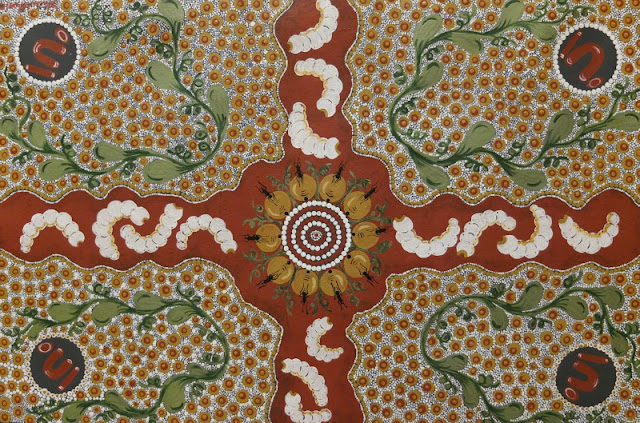These vibrant and collectable paintings are a relatively recent development in Australian Aboriginal culture. Aboriginal society evolved virtually without outside interference until the brutal disruption brought about by the arrival of the English convict ships in 1788.
Aborigines were hunter-gatherers with an oral tradition. This tradition included music, song, dance, and graphic expression – all of which is imbued with symbolic meaning.
A combination of forms may in fact be required for a concept to be fully expressed. Graphic expression played an important role in Aboriginal temporal communication as well as in tribal ritual – how important was not understood outside of the aboriginal world until the latter half of the 20th century.
Prior to the 1970s the public image of Aboriginal art was restricted to painted or burned decoration on utility items and "bark paintings". These "barks" are strips of eucalyptus bark that have been flattened, dried, and smoothed prior to decoration with brown, white, yellow, black, and occasionally red natural pigments. Traditionally these were only created as part of a ritual and were usually destroyed during or shortly after the ceremony. However, they became popular with collectors during the 1940s and have been widely produced for sale. Obviously, they originate only in areas with an adequate number of suitable trees. The best known work comes from Arnhem Land (north central Australia).
In 1971, Geoffrey Bardon, a teacher in an Aboriginal elementary school in Papunya (Central Australia near Alice Springs), had developed a close relationship with the local Aboriginal residents. He participated in ritual events usually prohibited to non-Aboriginals and had seen the splendid designs used in body painting and ceremonial “ground paintings”. In an effort to strengthen his students' pride and identification with their Aboriginal heritage, he assigned them a project – to design and paint a school wall mural on the subject of the honey-ant, a key totemic animal to the region. The mural did not progress as quickly as anticipated, particularly considering the childrens' love of drawing. What even Geoffrey Bardon did not understand was that painting this story was in itself a ritual act and restricted on the basis of personal heritage and degree of initiation into tribal law. Several local elders became involved. Through the new medium they discovered a way to re-establish their connection with the land they had lost. They were called the 'Painting Men', and they gave the outside world a first look at Aboriginal art other than bark painting.
What emerged were pieces with an astonishing and vibrant aesthetic sophistication. This work gave the appearance of rapid evolution only because it was realized after millenia of development. Unfortunately I was unable to find any images of this mural – it was painted over by maintenance men in the 1970s.
Use of a complex ritual symbolic structure, widespread rock painting, body painting, and drawing in soft earth for communication and story telling were all well established practices in Aboriginal life. This "new" medium spread like wildfire across the country. The Australian government slowly came to recognize Aboriginal artistic expression as a national resource, and for this as well as humanitarian reasons, it began to support the art movement by providing materials, exposure to new techniques, and establishing authorized contact points for outback dwelling groups. Now, although this was not always true, these contact points are managed and monitored by the Aboriginal community itself.
 |
 |























































Wow
ReplyDeleteAmazing blog to follow
I would suggest to follow my all friends and family to follow his blog .
Great and readable contect provided by the blog owner.
Keep Posting
Softcube
I am interested in learning Aboriginal Art and homemade dotted painting cards. Please help and recommend some steps to learn this type of art.
ReplyDelete